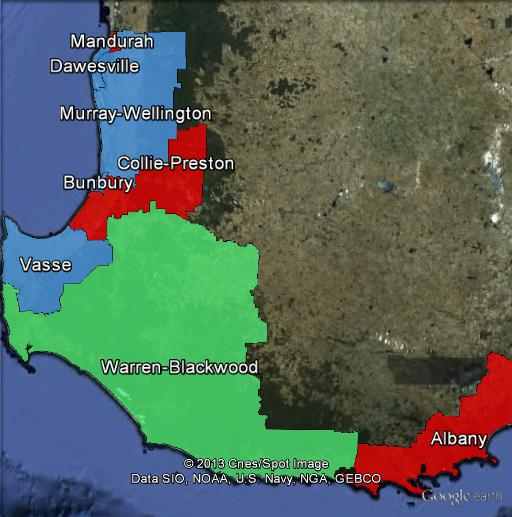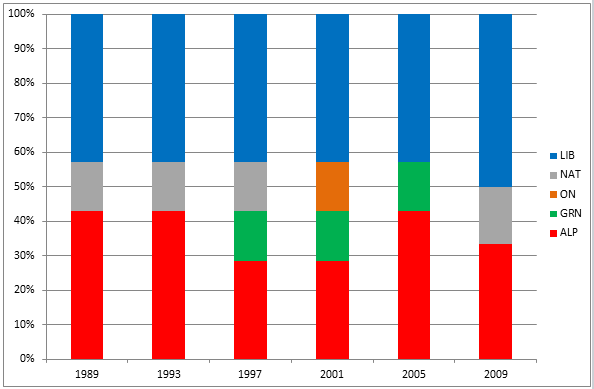Incumbent MLCs
- Adele Farina (Labor), since 2001.
- Nigel Hallett (Liberal), since 2005.
- Colin Holt (Nationals), since 2008.
- Barry House (Liberal), since 1989.
- Robyn McSweeney (Liberal), since 2001.
- Sally Talbot (Labor), since 2005.
Geography
South West covers the southwestern corner of the state, stretching along the coast from Mandurah on the southern fringe of Perth to Albany on the state’s southern coast.
The region covers the districts of Albany, Bunbury, Collie-Preston, Dawesville, Mandurah, Murray-Wellington, Vasse and Warren-Blackwood.
The region includes four Liberal seats, three Labor seats and one Nationals seat.
The region includes the marginal Labor seats of Albany and Collie-Preston. Mandurah is a safe Labor seat, with the five conservative-held seats held by margins between 8.8% and 17.8%.

History
South West was created as a seven-member electorate in 1989.
At the first election in 1989, the ALP and the Liberal Party each won three seats, and the Nationals won one. This result was maintained in 1993.
In 1996, the Greens won a seat, taking the ALP’s third seat.
In 2001, the Nationals lost their seat to One Nation. At the first four elections in the region, the right (Liberal, Nationals and One Nation) won four seats, compared to three seats for the left.
In 2005, the left-right split was disturbed, with the ALP winning the seat won by One Nation in 2001.
In 2008, South West lost one of its seven seats. Labor and the Greens both lost a seat, and the Nationals won a seat after a seven-year absence.

2008 result
| Group | Votes | % | Quota |
| Liberal | 60,684 | 39.41 | 2.7584 |
| Labor | 50,908 | 33.06 | 2.3140 |
| The Nationals | 16,592 | 10.77 | 0.7542 |
| The Greens | 13,285 | 8.63 | 0.6039 |
| Family First | 6,024 | 3.91 | 0.2738 |
| Christian Democratic Party | 3,251 | 2.11 | 0.1478 |
| Others | 3,255 | 2.11 | 0.1480 |
On primary votes, the Liberal Party and the Labor Party each won two seats.
The race for the final two seats was primarily between the third Liberal (0.76 quotas), the first National (0.75 quotas) and the first Green (0.60).
After the elimination of minor candidates, the last six candidate standing were the first candidates for the Nationals, the Greens, Family First and the Christian Democratic Party, along with the third candidates for the ALP and the Liberal Party:
- House (LIB) – 0.7679 quotas
- Holt (NAT) – 0.7601
- Llewellyn (GRN) – 0.6350
- Sullivan (FF) – 0.3315
- Mondy (ALP) – 0.3122
- Lewis (CDP) – 0.1904
The CDP was first excluded, with most of their preferences flowing to Family First, and then the ALP was excluded, with most of their preferences flowing to the Greens.
- Llewellyn – 0.9350
- House – 0.7724
- Holt – 0.7690
- Sullivan – 0.5202
Family First preferences first flowed to the Nationals, and then to the Liberals, producing the final result:
- Holt – 1.0308
- House – 1.0056
- Llewellyn – 0.9542
The Greens’ Llewellyn lost by the slimmest of margins – about 1000 votes.
Candidates
- Labor
- Sally Talbot
- Adele Farina
- John Mondy
- Ian Bishop
- Aaron Dean
- Pearl Lim
- Nationals
- Colin Holt
- Sam Harma
- Dudley Greathead
- Shooters and Fishers
- Daniel Strijk
- Mark Mazza
- Nataporn Sri-Innop Ross
- Nataporn Sri-Innop Ross
- Janet Grogan
- Liberal
- Robyn McSweeney
- Barry House
- Nigel Hallett
- Ian Morrison
- Paul Fitzpatrick
- Michelle Steck
- Family First
- Bev Clusters
- David Bolt
- The Greens
- Giz Watson
- Hsien Harper
- Australian Christians
- Justin Moseley
- Tim Schoof
- Don Hyland
Preferences
The Greens and Labor swap preferences. Australian Christians, the Liberal Party, the Nationals and the Shooters and Fishers all give preferences first to Family First and then to each other.
The Shooters and Fishers are the only exception to this pattern, preferencing the third and fourth Liberals behind the Greens. The Shooters and Fishers still chose to preference the Nationals ahead of the Greens.
Assessment
The Liberal Party and the Labor Party each hold two safe seats. The last two seats, which were won by the Liberal Party and the Nationals last time, are in doubt. The conservative parties should easily win at least one of these seats, but could be in danger of losing the fourth conservative seat to either Greens or Labor.
For this to happen, there would need to be a swing to the left of less than 0.5%.
If this were to happen, the Greens would be the favourite to win the seat, barring a large swing to the ALP. The Nationals and Liberals would be in a tight contest as to which of them maintains its seat, and which one loses a seat to the left.
Current polling, however, suggests that the vote for the Nationals and Liberals will increase, and there will be no change in the current representation in South West.


I have been “playing” with Antony Green’s legislative council predictor calculator (apologies for mentioning another website here if that is bad form – I rarely participate in blogs) and it appears that the Shooters and Fishers have a very good chance of picking up two or three seats (SW, M&P and Agri) on the basis of a primary vote of as low as 2% due to the way preferences flow from the independents, FF and AC. Of course I have made some assumptions on how the other candidates will poll, but it appears, the independents roll up into the S&F which puts them in front of FF/AC which puts them in front of the second last major party candidate who then puts them over the quota. Agri is a bit different due to the ex-Nats running but the principle is the same.
Prediction: If the Libs hold or improve their position in the metro seats and win a third seat in SW, there is a reasonable chance (say 30%) that the S&Fs will hold the balance of power in the upper house and not the Nats.
Consequence: Nats may end up with up to 8 seats in the lower house and lose one (or extreme outside chance maintain their current seats) of their upper house seats and find themselves out of Government – good bye royalties for regions – if the libs can pick up enough Perth seats.
If this scenario comes to being, it is either brilliant strategic preferencing by the S&F and/or Libs or a complete fluke. Either way major change in “Government” in an election where the Premier remains the same.
Any thoughts?
Whatever the outcome, the Libs will not govern alone.
Given the Nationals’ (apparent) popularity in rural WA, and their inroads into Labor territory in the north, the Liberals need to keep them onside long term.
As long as the upper house has rural weighting, the Libs will have to share their majority with the Nats. An outright Liberal majority would involve 3 Lib seats in every region and a fourth in one… it ain’t likely. Winning a fourth seat in North Metro is best-case-only sorta stuff, and although the first five seats in Agricultural will generally go 2 Nat – 2 Lib – 1 ALP, picking the last is messy. It could easily go to a minor right-wing party, or to Labor (only 1 seat out of 6 is pathetic, they’ve gotta figure out how to do better than that), and this time Max Trenorden has a very good chance due to the Tier 3 issue. (If you don’t know what that is, google it.)